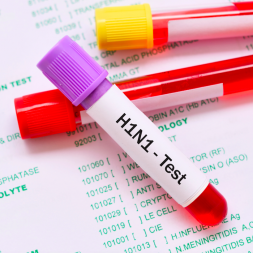5 Lesser-Known Facts to Help Make a Flu Diagnosis
How accurate is the flu swab? Can I just use clinical intuition? And more…
I’m still crossing my fingers that the last shift I worked in the ER won’t leave me sick with the flu. It seems like every other patient I saw tested positive for influenza A. As nurse practitioners this time of year, in many settings we’re bombarded by sick patients. While we can’t do much for viral syndromes in most cases, there are some general guidelines we must abide by and helpful information to know that impacts diagnosis.
Are flu swabs reliable when it comes to making a definitive influenza diagnosis? What affects their accuracy? If you’re an NP working with acutely ill patients, I thought it seemed an appropriate time of year to answer your burning questions about influenza testing.
How accurate are flu swabs?
There are two primary methods for testing a patient for the flu, laboratory diagnostic testing and rapid influenza diagnostic testing (RIDT). While lab testing is very accurate, this method requires expensive equipment and takes about 48 hours to get results. So, this method is typically only used by the CDC to detect which influenza strains are circulating.
In the clinic and hospital setting, nurse practitioners most commonly use RIDT. This mode of testing however isn’t very accurate. RIDT correctly identifies individuals with influenza just 62.3% of the time. The test does better at correctly identifying individuals who do not have influenza with a 98.2% success rate. Sensitivity is slightly higher in children than in adults as they shed more of the virus making it easier to detect.
The takeaway? A positive flu test result is pretty reliable. A negative result not so much – this has a good chance of being a false-negative.
 When can a flu swab be collected?
When can a flu swab be collected?
Influenza swabs should be collected as close as possible to the start of an individual’s symptoms. Accuracy of influenza testing decreases substantially after about 4 days of symptom onset. Influenza may be detectable for slightly longer periods in children.
Note: immunosuppressed individuals may have detectable influenza virus for prolonged periods, even weeks to months.
Does it matter which brand of RIDT my clinic uses?
More than 10 different RIDTs are FDA approved. Studies have not found any significant difference in accuracy between these brands. However, it’s important that RIDT kits are stored as directed and not used after expiration as this can affect results. Finally, use the swabs that come with the kit. Doing otherwise can affect accuracy of the test.
Can nurse practitioners rely on clinical intuition to make a diagnosis?
Studies show that healthcare providers are just OK when it comes to deciding if a patient does or does not have influenza without testing. Clinical diagnosis based on the presence of fever and cough correctly identifies individuals with the flu just 64% of the time and correctly identifies those without the disease about 67% of the time. However, it should be noted that clinical judgment is slightly more reliable in making a positive influenza diagnosis than RIDT!
Is RIDT cost effective?
I’ve worked in many clinics where influenza testing isn’t widely used as it is perceived to be an additional cost to the patient. While RIDT is an expense, there’s some controversy about its cost efficacy. Klesper et. al., for example, found that RIDT reduced overall claims to health insurance companies for influenza-related healthcare costs over a 2-year period ($62.46 vs. $192.83). RIDT resulted more appropriate prescribing of antiviral therapy. Authors of the study concluded that “when an RIDT is was employed to aid in clinical judgment, treatment decisions are based on evidence rather than “clinical feelings”, a practice that translates to effective antiviral stewardship”.

